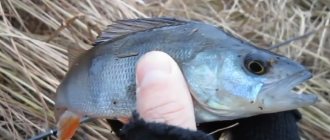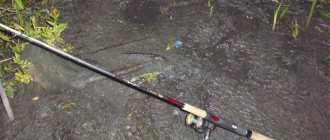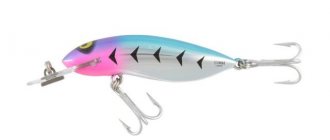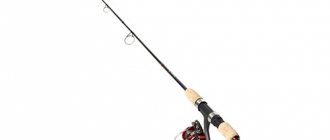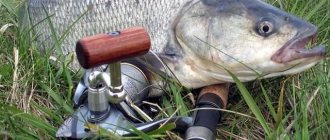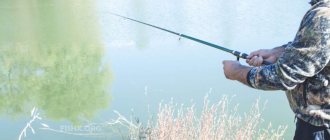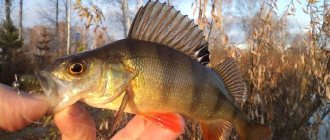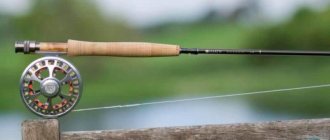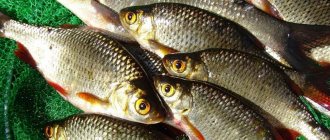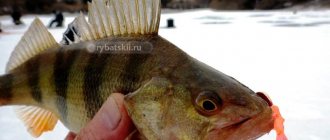Perch can be caught all year round. In winter, fishing for it is carried out with varying success, but after the opening of reservoirs, it is one of the first to become active and take baits intended for fishing in open water. Fishermen prepare for this happy moment in advance: they put their gear in order, check spinners, wobblers and silicone lures, and pull out spring fishing equipment from distant corners.
Fishing for perch in the spring begins as early as March, and many striped fishermen claim that it was during this time that they managed to get the biggest trophies. But at the start of the season, the predator’s bite is unstable and is influenced by a number of factors, such as changeable weather and low water temperature. In April, it finally emerges from its winter sluggish state and quickly takes the offered bait. Perch fishing will be no less productive in May. True, in the second half of spring, humpback whales are caught much less frequently; small and medium-sized specimens predominate in the catches.
Characteristics of the fishing object
Perch is an insatiable, always hungry predator. When he goes out to feed, he grabs everything that fits in his mouth. For such greed and energy, he is disliked by floaters aimed at peaceful fish. Sometimes small bass literally prevent you from casting your line, grabbing the bait before it even reaches the bottom. But when large specimens sit on the hook one after another, the perch activity no longer causes dissatisfaction.
In terms of prevalence in our region, perch ranks second after roach. The fishing literature indicates its maximum size - 50 cm in length, and weight - up to 2 kg. In fact, such giants are very rare, so individuals weighing 0.5-1 kg are already considered trophy. Sabaneev once wrote that the largest perches live in Lake Onega, and today quite large specimens are caught in the Volga basins.
The predator spawns early, in some areas as early as March. A few days after the spawn, he begins to actively recuperate. This is the same notorious net that fishermen love to talk about.
It will not last long, so it is important not to miss this period of grace.
Perch in early April
Being a schooling fish, this striped predator goes to spawn from the beginning of April until the middle of the month. Even if an angler comes to catch perch without a boat. He will still find a place in the reeds to catch fish. Having caught one perch in a school, it is possible that other fish will be hooked.
Efficiency is needed so that the flock does not have time to disperse throughout the reservoir.
The main feature of fishing in early April is that changeable weather will not affect the perch catch in any way.
A spinning spoon will be the best bait for perch. All that remains is to monitor the bait and adjust the depth to which the spoon sinks.
As bait you can use:
- fresh fish meat;
- live bait;
- fry roach tail;
- crustacean;
- worm.
It is at the beginning of April that the voracious perch is ready to rush to any of these baits to get enough, and its vulnerability pushes it to the chance of being caught.
Fishing in the spring is more exciting because you can experiment with baits and lures to see what is the best way to catch this predator and what should be put off.
Search for a predator
In early spring, while the water is still cold, the fished object sticks to the bottom horizons and practically does not rise to the surface. Usually it hides from pike and other large predatory fish behind edges and small slopes, and can stand in hollows with a slow or swirling current. He is also attracted to snags and supports of hydraulic structures. High chances of success will be in places where tributaries and streams flow into the main channel. On lakes, stripers concentrate near local bottom anomalies: holes, grooves, tubercles and other irregularities.
Spawning begins in early April, when the water warms up to 7-8 degrees (approximately for most regions). River perch spawns first, since rivers are free of ice earlier. At this time, you can catch its lake brother, which is just getting ready to spawn. Small and medium-sized striped predators gather in large schools and migrate to spawning grounds - shallow, quiet areas where there is little or no current. Humpback whales, on the other hand, stay isolated or in a group of no more than a dozen individuals. The former should be looked for in shallow water with fallen branches and last year’s vegetation at the bottom, and the latter – at depths of up to 4 meters. The spawning of a large perch will begin a little later, but for now it behaves cautiously, rarely approaching the shore, so it is not easy to catch it.
Where to Look for Perch in Spring?
The best months for bass fishing are April and May.
The water is still cold and just starting to warm up. Perch stays at a depth of 2 meters and deeper. The smaller ones try to be closer to the shore near the aquatic vegetation, but the larger ones are in holes, or another favorite place is the presence of snags or a rocky ridge.
To catch small specimens, it is best to throw the bait along the edge of aquatic vegetation, or there are also such corridors of grass and reeds, these are just right.
But you should be careful, as there are also a lot of hooks there. Based on this, it follows that where there is a lot of vegetation, the bait should preferably be placed in the water floor; accordingly, where there is little of it, we carry it along the very bottom.
Spawning for perch begins around mid-April, at which time it takes on everything that moves. During spawning it is neither visible nor heard.
But after spawning, the perch begins to get fat, so to speak, and you can catch it in very large quantities. It is not difficult to find the habitats and bites of perch; splashes and turbulence are usually visible on the surface of the water, which is how it chases the fry.
Microjig in Early Spring. Video
Spring fishing for perch with a float rod
On a warm spring day, perch can be caught well using float tackle. It must be said that in the spring, a fishing rod with a float often brings larger catches than a spinning rod. As a rule, it consists of:
a lightweight and convenient telescopic rod 4, 5 or 6 meters long;- a simple spinning reel (there are no special requirements for it, since in this type of fishing there is no need to do wiring);
- main line 0.2 mm;
- a float of any shape (everyone puts the float they are used to, the main thing is to load it correctly);
- thin leash with a breaking load of 2-2.5 kg;
- pellet sinkers;
- a hook that matches the size of the bait (the striped robber is not afraid of overly large hooks, but it is better not to place such hooks, otherwise he will simply rip off the bait).
What to catch? The predator, hungry over the winter, takes on any live bait, be it bloodworms, maggots or worms. You can also offer him a small live bait (for example, a verkhovka). The secret to success in float fishing for perch is constant play with bait. To do this, you need to raise and lower the equipment, maintaining certain pauses between lifts. When biting is active, the pauses are short, and if there are no bites for a long time, their duration should be increased. This method is reminiscent of winter fishing, only larger tackle is used. Sometimes it is useful to experiment with fishing depth, because a school of perch can stand not only at the bottom, but also in the middle horizon.
Gear selection
Freshwater bass are not very large, so fishing for them does not require heavy rods. If fishing occurs without long casts, forms with a length of 1.8 to 2.4 meters are suitable. If long casts are needed, models with a length of 2.4 to 3 meters are available. For jig fishing or at great depths, baits weighing 35-40 grams are used. In other cases, up to 20 grams of dough is enough. These could be the following rods:
- 1. Extreme Fishing Panache Obsession 742M all-rounder. Suitable for shore fishing and fishing from a boat. The blanks have a medium-fast action, are 2.2 meters long, and have a test range from 4 to 18 grams.
- 2. Models Craft Rizer RZS-702M, designed for jigging and jerking with various wobblers and poppers. The length of the rods is 2.1 meters, the test range is from 6 grams to 24 grams.
- 3. Norstream Spiker 832MH blanks with a decent power reserve and dough from 10 grams to 37 grams. They work effectively with different baits and allow you to catch perch in fast-flowing rivers and at depth.
For perch hunting in the spring, reels with dimensions from 1000 to 2000 Shimano are used. It is desirable that they be suitable for thin fishing line or braid, be equipped with small-capacity spools that allow you to do without backing, and have good traction. The number of slips will be reduced by monofilament line up to 0.2 millimeters thick, braided line up to 0.1 millimeters thick.
This is interesting: Catching perch in the spring with a spinning rod
Fishing for perch using a spinning rod in spring
In the spring, when spawning bans are in effect, including navigation, many fishermen prefer to catch perch using a spinning rod. On large rivers, where there is a possibility of a pike or other large predator biting, light class tackle is used, and on small bodies of water (narrow rivers, lakes) it is more convenient to use a delicate ultralight spinning rod. This tool has the following characteristics:
rod - a light and at the same time quite durable blank with a test weight of up to 15 g and a length of 2.4 meters:- the reel is a high-quality, inertia-free model that ensures smooth running and smooth winding (spool size for light - 2000, for ultralight - 1500);
- fishing line - braided with a diameter of 0.18-0.2 mm.
Why braided cord? It has several undeniable advantages, the main ones being high sensitivity and the ability to withstand severe loads, including when hooked. Snags occur more often in spring than at any other time of the year. This is all due to the flood, which changes the nature of the bottom. Snags can appear in any area, even where the bottom surface has always been clean before.
Artificial baits for catching perch on a spinning rod in the spring from the shore can be very different. Let's start with the simple ones.
Spoons
Beginners who have heard plenty of stories about the spring feast of the striped predator seem to think that catching it with a spoon is not particularly difficult. In fact, there are some nuances here.
Let us remind you that in spring the probability of snagging increases, while the vast majority of oscillations are not non-snagging.
In addition, in March the perch is not yet active enough, so it often ignores the oscillating spoons with sluggish play. That is why in the first half of spring it is advisable to give preference to spinners of bright colors, which create more noise when moving and are better visible in cloudy water. If the choice nevertheless fell on oscillating spoons, then you should not use too large “pieces of iron”, which the object of fishing will ignore for the reason that it will not be able to swallow them.
Favorable (unfavorable) conditions for perch fishing
3
After stabilizing the water temperature from +8
O
, sexually mature individuals begin to move to the spawning grounds. Females, accompanied by flocks of males, head to shallow areas with snags, flooded trees and last year's vegetation.
The readiness of a fish to spawn is determined by a change in appearance. The color becomes brighter. Pre-spawning activity of perch (zhor) refers to favorable conditions for catching it in April. During this period, a large perch on a hook is not so uncommon.
Favorable conditions for perch fishing in April:
- No sudden changes in atmospheric pressure;
- Established warm weather without night frosts for several days;
- Cloudy, windless and relatively warm days;
- Brief morning fogs;
- Short drizzles.
Unfavorable fishing conditions:
- A sharp drop in daytime temperatures and night frosts;
- Quick change of water level;
- Prolonged rains leading to cold temperatures;
- Atmospheric pressure surges.
Features of postings
Active spring fry forces the perch to chase the “live ones”, so it is necessary to maintain frisky, lively animation.
After casting the bait:
- Let it sink to the bottom.
- Wait 2-3 seconds.
- Make the line slack and perform 3-4 active turns of the reel to lift the bait above the bottom.
- Let it level onto the ground.
- Repeat the cycle.
This technique is reminiscent of frog jumping. To add brightness to the game, variations are possible in the form of tossing with the tip of the rod.
It is important that the reeling takes place on slack, and not on a stretched line. The moment the perch takes the prey, the elastic string will pull the bait back out of its mouth. This will disrupt the bite and the fish will “lag behind” such food for a long time. The perch's lips are weak; a sharp hook will tear the mouth.
Lure
Animal food should be added to spring bait. Bloodworm is affordable and popular.
Read! Ultralight for rudd
Possible recipe
Homemade dry white bread is used as a base. The bloodworm awaits its fate in a cool place. It is not recommended to use a refrigerator due to the specific smell of larvae. The bread is pre-ground on a grater. Add an attractant. Bread and “meat” are delivered to the place of use separately from each other.
Mix in the following proportion: 20% crackers, 80% bloodworms. The feed ball has good stickiness. A stable cloud forms in the water, attracting with its shape and smell.
Spring perch fishing requires knowledge of the behavioral characteristics of the fish. The correct selection of gear and lively, interested animation of the bait will guarantee you a good catch.
Perch biting in April
Bloodworms are the best choice for voracious perch. An equally effective bait can be corn dough or dung and earthworm.
In the second month of spring, perch prefers to live close to the shore on the bottom with a slight current. For this kind of fishing, a float rod with a strong fishing line, hook and float is suitable. When biting, the perch loses caution, and in order not to miss this fish, the bait is lowered to the bottom and then sharply hooked.
Feeding the striped predator throughout April is not required , as it will be overwhelmed by an endless glutton.
Fishermen who decide to choose deep places in reservoirs will definitely catch large specimens of perch, only for this they will need a rubber boat or motorboat.
